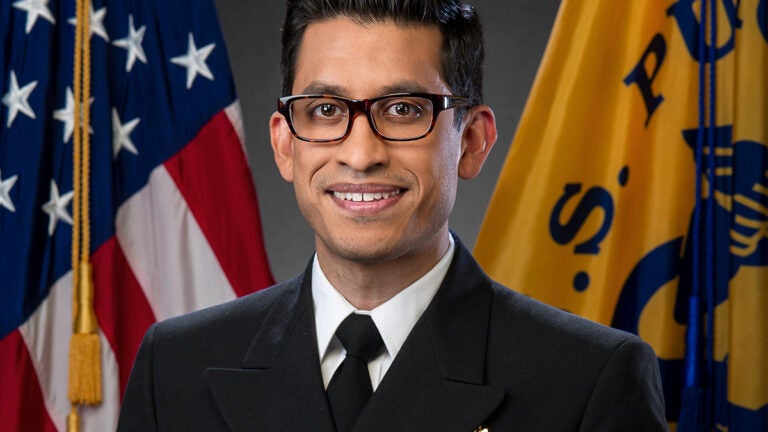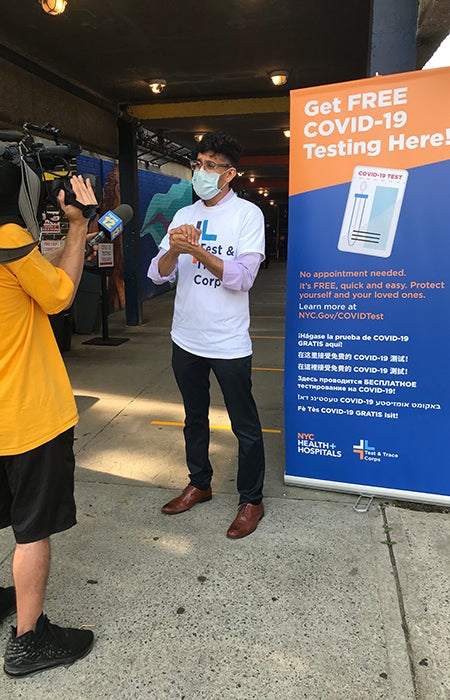
Epidemiologist Neil Vora leads COVID-19 contact tracing efforts in New York City
Neil Vora is a disease detective.
A physician and epidemiologist with the U.S. Centers for Disease Control and Prevention, Vora’s focus is combating emerging infectious diseases. Currently stationed at the New York City Health Department and New York City Health + Hospital Corporation, Vora is currently leading the city’s contact tracing effort for COVID-19.
Since the city began preparing for a widespread outbreak of coronavirus in mid-January, Vora has filled a variety of different roles in the Health Department’s COVID-19 response. Initially serving as the clinical operations section lead, he oversaw teams conducting laboratory testing, surveillance, healthcare system support, and communications to providers.
More recently, he was asked to set up and lead the city’s contact tracing effort — a phased approach that he and his team hope will allow them to quickly identify cases and implement control measures to reduce transmission.
“Our hope is that there can be a calculated reopening of New York City. Along with that, we’re doing very extensive case investigations and contact tracing to make sure that we can prevent a huge resurgence of the virus,” says Vora, a USC Renaissance Scholar who graduated from USC Dornsife with a double major in biology and international relations and a minor in philosophy in 2004.
“I can’t imagine doing anything more gratifying right now than helping New York City,” he told me. “We’ve been hit so hard, so to be able to give back is such a privilege.”
Vora spent much of 2019 working on a measles epidemic in New York — the largest measles outbreak in the country since 2000 when measles was eliminated from the United States — and later deployed to the Democratic Republic of the Congo to assist in infection control efforts around the second largest recorded outbreak of Ebola worldwide. He also worked on the 2014 Ebola outbreak in Liberia and monitored the virus in New York City in 2015, a year before setting up the city’s Zika virus testing coordination program.
Ironically, the last time I spoke to Vora in 2018, he told me about a trip he had taken to a remote region of Nigeria where he had gone to investigate an annual festival of bats — mammals that are known to carry a range of deadly viruses, including filoviruses (the same group of viruses that include Ebola), rabies and — as we now know all too well —some coronaviruses.
At the time, Vora acknowledged that people sometimes wonder why the U.S.-based CDC cares about what’s happening in a remote region of Nigeria. His response then appears particularly prescient now: “Our perspective at CDC is that a health threat anywhere is a health threat everywhere because an infectious disease is only as far as one plane ride away,” he said. “It’s in the interest of the U.S. to build health security around the world.”
Here, Vora answers seven questions about the coronavirus and our current response to it.
What are some of the unexpected ways the virus has behaved?
There are so many scientific questions that have yet to be answered about this new virus. In certain ways it behaves similarly to its cousin viruses, such as SARS and MERS. But at the same time, it also has behaved in surprising ways.
One surprising feature is that there is transmission of this virus before a person even shows any symptoms. That leads to challenges from a public health perspective because people can be infectious before they are coughing or sneezing. This contributes to the virus’ ability to spread.
We’re also seeing some unusual and surprising manifestations of the virus in certain instances. We have to learn about how it infects the body and how it causes mortality so we can try to save lives by making sure people have the right information to take the steps that they need to stay safe.
Scientists deduce that coronavirus was transmitted from a bat to a human. What credence, if any, do you give to those who suggest that it came from a laboratory?
We know from many other viruses — Marburg virus, which is related to the Ebola virus; Rabies virus; some coronaviruses — that a variety of different viruses originate in animals and particularly in bats.
Bats provide many benefits to humans, so we shouldn’t vilify them. But humans who interact with bats without the proper protective equipment can suffer health consequences as a result. The way that we think this coronavirus emerged is through human interactions with animals, so it’s possible that there was a spill over

Neil Vora being interviewed by News 12 during an event to promote testing for COVID-19 in New York City on July 8. (Photo: Courtesy of Neil Vora.)
event from wildlife to humans, or maybe wildlife to domestic animals to humans — that’s the pattern that we’ve seen before and the genetic sequence of the virus suggests that it’s very closely related to other bat coronaviruses. All of this is strong evidence that this really does have an animal origin.
Where can people get reliable information about COVID-19?
Sometimes there seems to be an epidemic of misinformation and that is really harmful. We see misinformation that has been deliberately spread on vaccines. We are also seeing deliberate attempts to spread misinformation on COVID and that hampers efforts to control this virus. It’s really important that people get their information from reliable sources, such as the CDC website, the World Health Organization website or their city’s health department website.
Is it surprising to you that a pandemic of this nature emerged and what can we do to prevent future occurrences?
A lot of experts would say that it’s not surprising that a new respiratory virus like this has emerged. The evidence suggests that it came from an animal source. Sadly, even when we’re done with this pandemic — and there will be an end — there are going to be future threats from novel viruses.
We therefore have to think through how we build preparedness and that response capacity, and maybe even think further upstream to how we prevent outbreaks from happening in the first place.
In particular, I’m referring to factors such as how humans interact with animals and the environment. Such interactions place humans in close contact with animal pathogens. In fact, around two-thirds of all new infectious diseases come from animal sources. And so that’s why I’m saying it’s not surprising that the virus that causes COVID has spilled over from some animal into humans. Of course, no one could have predicted that it would be exactly this virus and it would unfold like it has.
By starting to open up while the number of new cases and deaths are still high, and in some places rising, are we risking a second, possibly even more deadly wave?
We have to be prepared for the possibility that the virus is going to come back in a second wave, maybe even a third. That risk is going to be there until we have an effective vaccine. If people are not following strong public health recommendations that are based in science, there is a risk that they could get infected and spread the virus to others.
We’ve also seen a great deal of fallout from other health conditions, such as deteriorating mental health and chronic diseases that are exacerbated because people have not received the care they need.
No matter how you look at it, this is a really challenging time. Most of our lives have been deeply affected.
What in your opinion have New Yorkers done well to contain and defeat the virus?
I think New Yorkers have done an amazing job despite really challenging circumstances. Our daily number of new cases was really alarming during March and April, but we’ve seen it decrease since then. That’s because of the work New Yorkers did together. New Yorkers physically distanced from each other, they chose not to leave their homes except for essential reasons, and they wore face coverings. These were all critical steps to ending that first wave.
Why is global cooperation so important if we are to be successful in fighting COVID-19?
A health threat anywhere is a health threat everywhere. We have to work together around the world to address infectious disease threats, because viruses do not care about nationality. Some viruses don’t even care about species. In the end, whether we’re two humans on different sides of the world, or whether we’re a human and a bat, we are all connected on this planet. We have to remember that.”